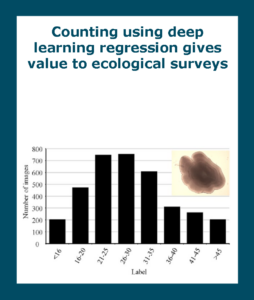Many ecological studies rely on count data and involve manual counting of objects of interest, which is
time-consuming and especially disadvantageous when time in the field or lab is limited. However, an
increasing number of works uses digital imagery, which opens opportunities to automatise counting
tasks. In this study, we use machine learning to automate counting objects of interest without the
need to label individual objects. By leveraging already existing image-level annotations, this approach
can also give value to historical data that were collected and annotated over longer time series
(typical for many ecological studies), without the aim of deep learning applications. We demonstrate
deep learning regression on two fundamentally different counting tasks: (i) daily growth rings from
microscopic images of fish otolith (i.e., hearing stone) and (ii) hauled out seals from highly variable
aerial imagery. In the otolith images, our deep learning-based regressor yields an RMSE of 3.40 dayrings
and an R
2 of 0.92. Initial performance in the seal images is lower (RMSE of 23.46 seals and R
2 of
0.72), which can be attributed to a lack of images with a high number of seals in the initial training set,
compared to the test set. We then show how to improve performance substantially (RMSE of 19.03
seals and R
2 of 0.77) by carefully selecting and relabelling just 100 additional training images based on
initial model prediction discrepancy. The regression-based approach used here returns accurate counts
( R
2 of 0.92 and 0.77 for the rings and seals, respectively), directly usable in ecological research.
